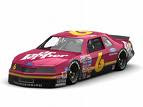
Build a special paper airplane to demonstrate how and why airplanes and most birds can fly (when they're not flapping their wings). Cut out the airplane's shape along the dark solid line. Next, fold the top half at the dotted line so that it meets the bottom half. Don't, however, fully crease the paper at the fold (we want to make a nice 'tear drop' air foil shape).
After folding the paper back, put a small piece of tape at the wing tips and at the center at the points marked A, B, and C. Now fold the plane along the center crease so that it creates a flattened out 'V'. The angle of the 'V' should be no more than about 15 degrees. Test fly the plane and adjust its stability.
Keep the nose of the plane from rising (stalling) by adding a small weight to the nose (point D), a paper clip or two does nicely. You can also adjust how much the plane dives or climbs by cutting small slots in the tail of the plane and bending the paper at the cuts up or down. Experiment with putting them up or down and seeing what effect that has on the way the plane flies.
What's going on?
Contrary to popular belief, airplanes don't float on the air, they're sucked up into it. This reason is known as Bernoulli's Principle. It says: "...as air travels faster [than surrounding air] across a surface, the air pressure against it is reduced...". By curving the top of an airplane's wing, air above it has to travel farther (as the distance is greater) than the air below, forcing the air to move faster.
The result is lower pressure on top and more pressure on the bottom. Another name for this is lift. The higher pressure below the wing is just like someone pushing from below the wing; the lower pressure above the wing is like someone pulling it up (like sucking on a straw to draw up milk in a glass).
If a wing has enough lift upwards, it moves upward, if a wing has lift downwards, it moves downward. The plane that we built, the "Bernoulli Plane" has a real airfoil and more closely resembles and flies the way that real planes and most birds do.
Tuesday, March 25, 2008
Paper planes
Posted by
Leslie
at
9:24 PM
![]()
Labels: paper planes, science experiment
Subscribe to:
Post Comments (Atom)










0 comments:
Post a Comment